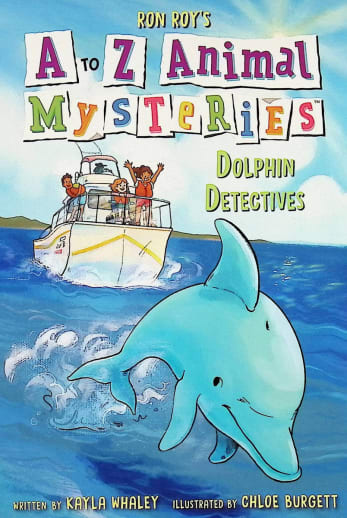While out sailing, Abbi and her friends notice the dolphins are acting strangely. Could something be going on? Full-color illustrations and easy-to-read text make this mystery a great fit for young readers. Find a list of dolphin facts in the back of the book as well! Recommended for grades 1-4. 96 pgs, pb.
A to Z Animal Mysteries #4: Dolphin Detectives
SKU
034249
ISBN
9780593489086
Grade 1-4
These icons are designed to help you quickly understand and learn important information about our products.
Teaching Method
Traditional
Teacher-centered curriculum commonly used in classrooms that may include a text, teacher manual, tests, etc.
Charlotte Mason
A methodology based on the work of a 19th century educator who maintained that children learn best from literature (Living Books), not textbooks.
Classical
A methodology based on the Latin Trivium (three stages of learning), including the grammar stage (memorization and facts), logic stage (critical thinking), and rhetoric stage (developing/defending ideas).
Unit Study
A thematic or topical approach centered around one topic that integrates multiple subject areas.
Montessori (Discovery)
A methodology based on the work of a 20th century educator that emphasizes student and sensory-driven discovery learning and real-life applications.
Other
Other methodologies
Religious Content
Secular
Contains content contrary to common Christian beliefs (i.e. evolution).
Neutral
Avoids religious or theoretical topics or presents multiple viewpoints without preference.
Christian/Religious
Faith-based or including instructional religious content.
Learning Modality
Auditory
Learns through listening, talking out loud or reading out loud.
Visual
Learns through seeing, prefers written instructions and visual materials.
Kinesthetic/Tactile (Hands-On)
Learns through moving, doing and touching.
Multi-Sensory
Curriculum that employ a variety of activities/components.
Presentation
Sequential
Curriculum progresses through well-defined learning objectives. Emphasizes mastery before moving to the next topic.
Spiral
Topics and concepts are repeated from level to level, adding more depth at each pass and connecting with review.
Conceptual/Topical
Focus is on the “why,” often with a unifying concept as well as specific skills; coverage may be broader.
Teacher Involvement
Low Teacher Involvement
Student-led materials; parent acts as a facilitator.
Medium Teacher Involvement
A mix of teacher-led time and independent student work.
High Teacher Involvement
Teacher-led lessons; may utilize discussions, hands-on activities and working together.
Additional Materials Required
No other materials needed
Everything you need is included.
Other Materials Required
There are additional required resources that are a separate purchase.
Other Materials Optional
There are additional resources mentioned or recommended but are not absolutely necessary.
Consumable
Consumable
Designed to be written in; not reusable.
Non-Consumable
Not designed to be written in; reusable.
Our Price
$6.99 $6.99 $5.50
Rainbow Savings: $1.49
Description
Publisher's Description of A to Z Animal Mysteries #4: Dolphin Detectives
Solve Animal Mysteries from A to Z! Inspired by Ron Roy’s A to Z Mysteries series, this exciting animal adventure mystery is perfect for budding young chapter book readers. This time, 8-year-old Abbi and her friends solve a mystery with the help of dolphins!
It’s the weekend — a perfect day for a sail off the coast of Maine. But there’s something fishy going on with the local dolphins and Abbi, Lydia, and Daniel are determined to find out why. Are the dolphins twisting, leaping, and whistling because they’re playing? Or is it a warning of nearby danger? And if it’s danger, how can the kids get grownups to believe them? Abbi and her friends are diving head first into this mystery!
It’s the weekend — a perfect day for a sail off the coast of Maine. But there’s something fishy going on with the local dolphins and Abbi, Lydia, and Daniel are determined to find out why. Are the dolphins twisting, leaping, and whistling because they’re playing? Or is it a warning of nearby danger? And if it’s danger, how can the kids get grownups to believe them? Abbi and her friends are diving head first into this mystery!
Category Description for A to Z Animal Mysteries
From bats to dolphins, explore the animal world with Abbi and her friends as they follow clues and solve mysteries to help the animals in their path. Full-color illustrations draw readers in, and easy-to-read text makes it a great option for newer readers. Each book focuses on one animal, and students not only learn about the animal as they read, but at the end of the book, they can find a list of facts about that animal too! Books are less than 100 pages long and recommended for grades 1-4.
Details
| Product Format: | Paperback |
|---|---|
| Grades: | 1-4 |
| Brand: | Random House Books for Young Readers |
| ISBN: | 9780593489086 |
| Length in Inches: | 7.625 |
| Width in Inches: | 5.1875 |
| Height in Inches: | 0.3125 |
| Weight in Pounds: | 0.35 |
Videos
Reviews

